Thuật toán định tuyến sử dụng vị trí gateway qua quảng bá gói tin hello trong mạng hình lưới không dây lai
Trong mạng hình lưới không dây lai (HWMN), lưu lượng chủ yếu tập trung đi và đến các gateway do
nhu cầu của các thiết bị di động là khai thác các dịch vụ trên Internet. Do đó, việc xác định tuyến
trong mạng HWMN đòi hỏi phải chú ý đến đặc tính lưu lượng này. Trong bài báo này, chúng tôi đã
đề xuất một giao thức định tuyến dựa trên vị trí gateway nhờ các thông báo hello nhằm hạn chế
vùng quảng bá của yêu cầu định tuyến trong mạng HWMN. Kết quả mô phỏng cho thấy hiệu quả
của giao thức đề xuất qua phân tích dư thừa các gói tin định tuyến và thông lượng mạng.
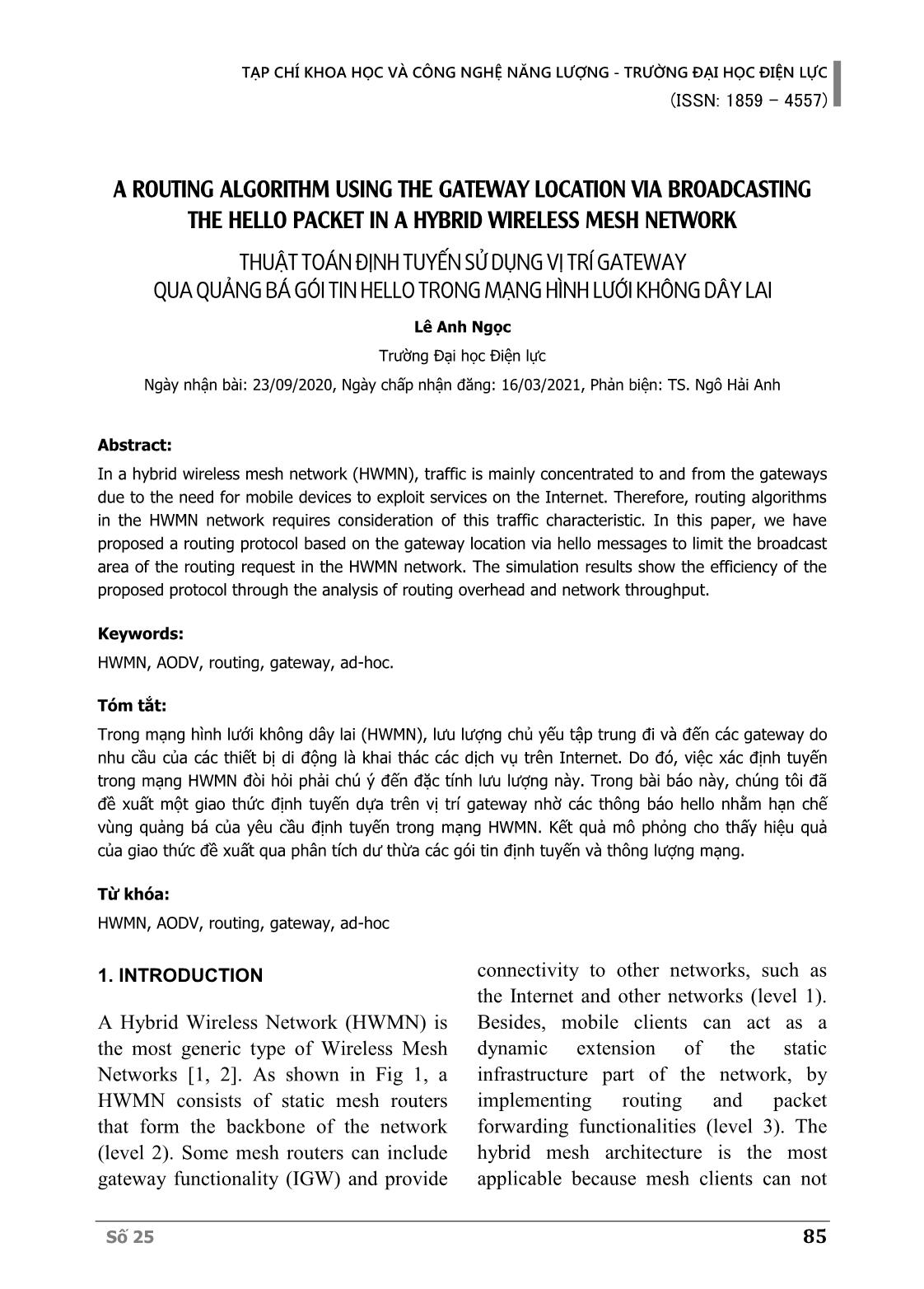
Trang 1
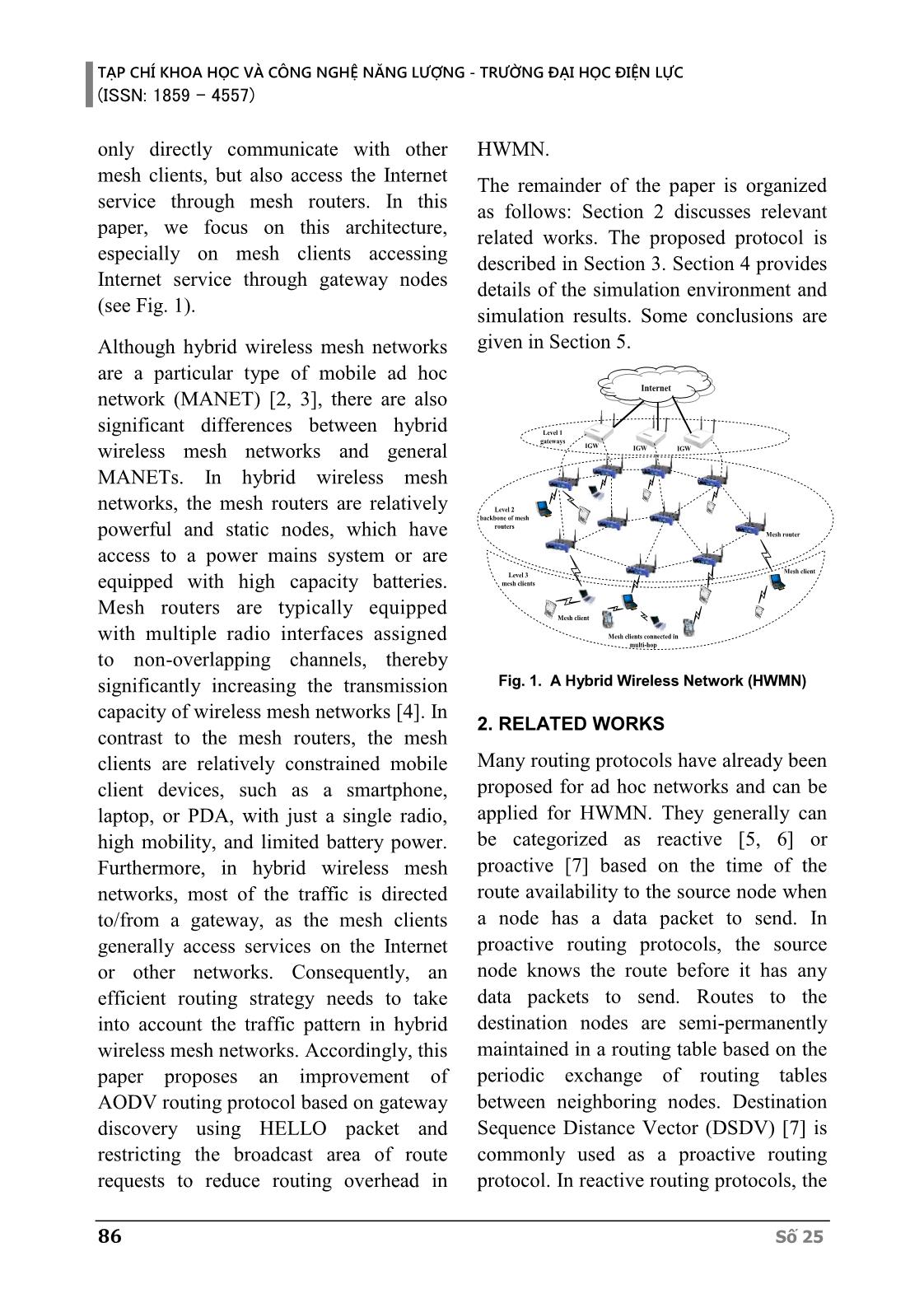
Trang 2
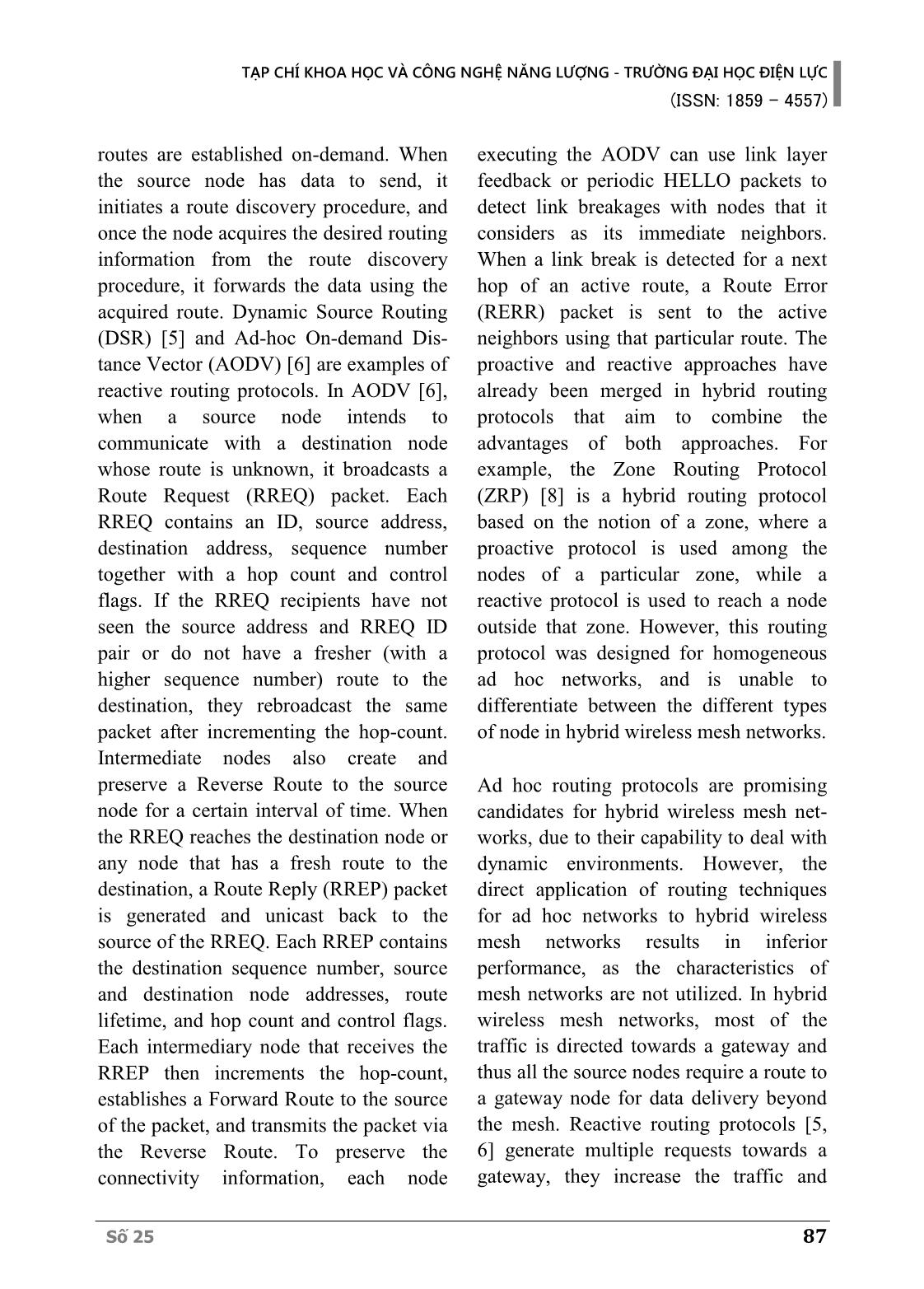
Trang 3
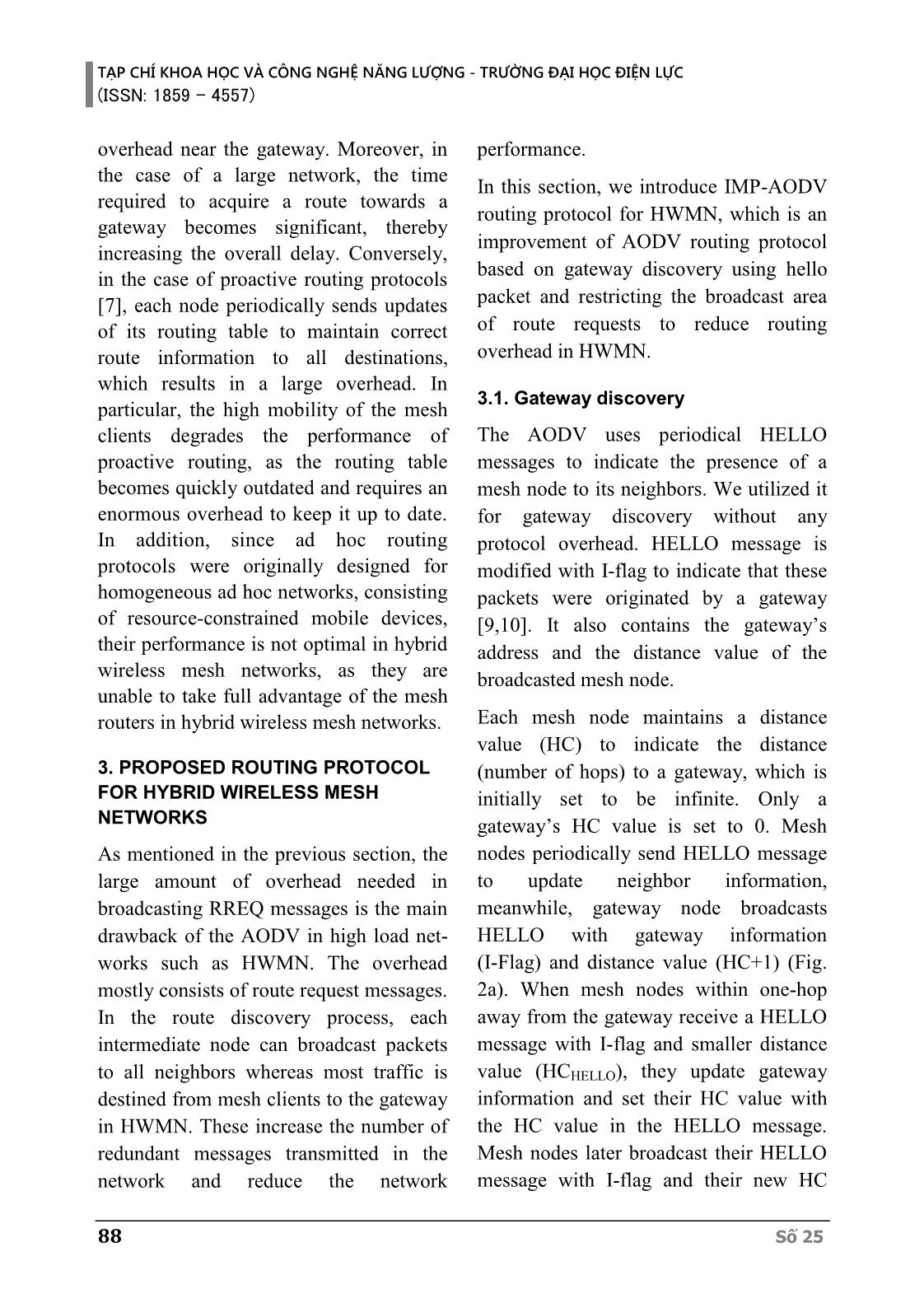
Trang 4
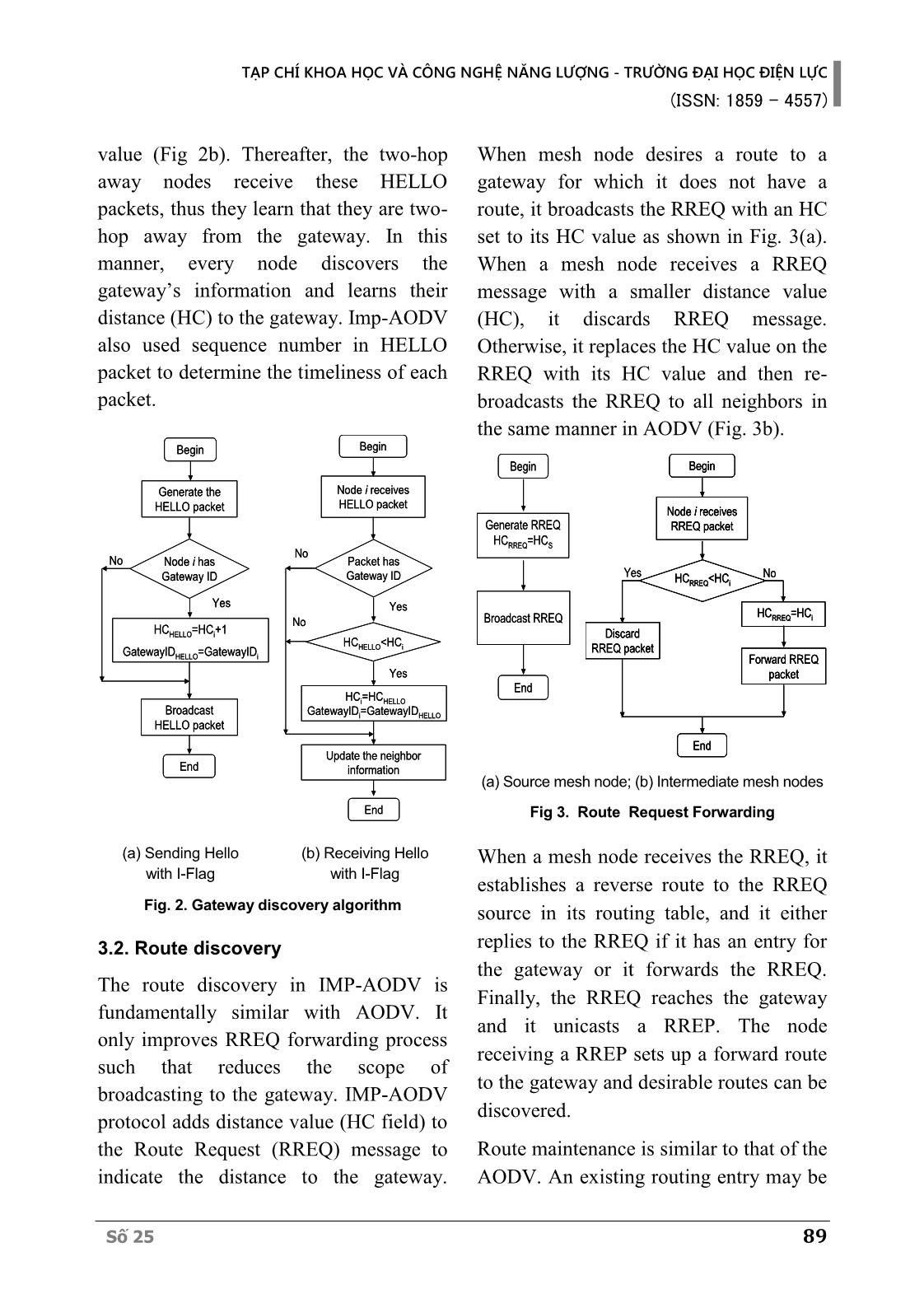
Trang 5
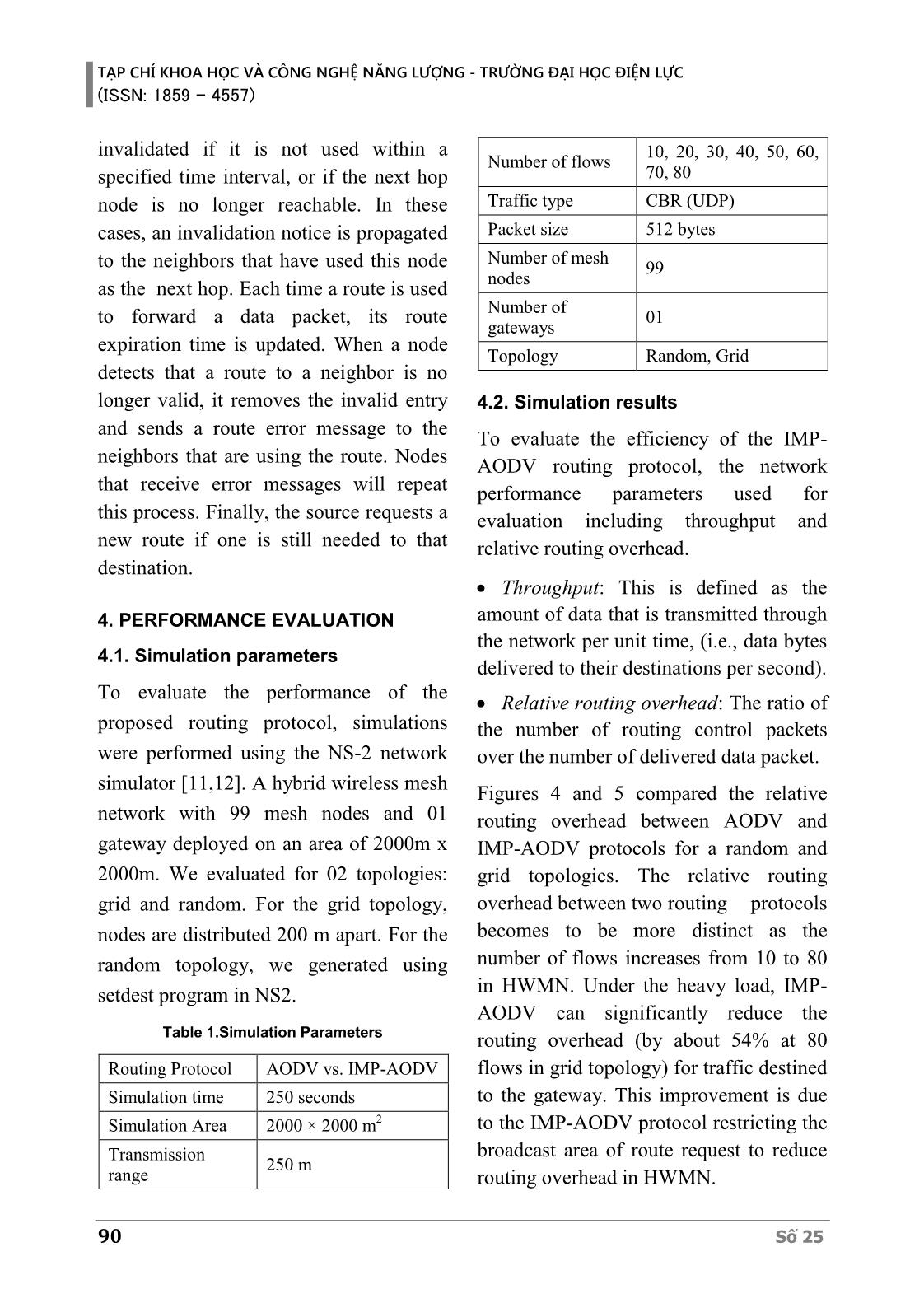
Trang 6
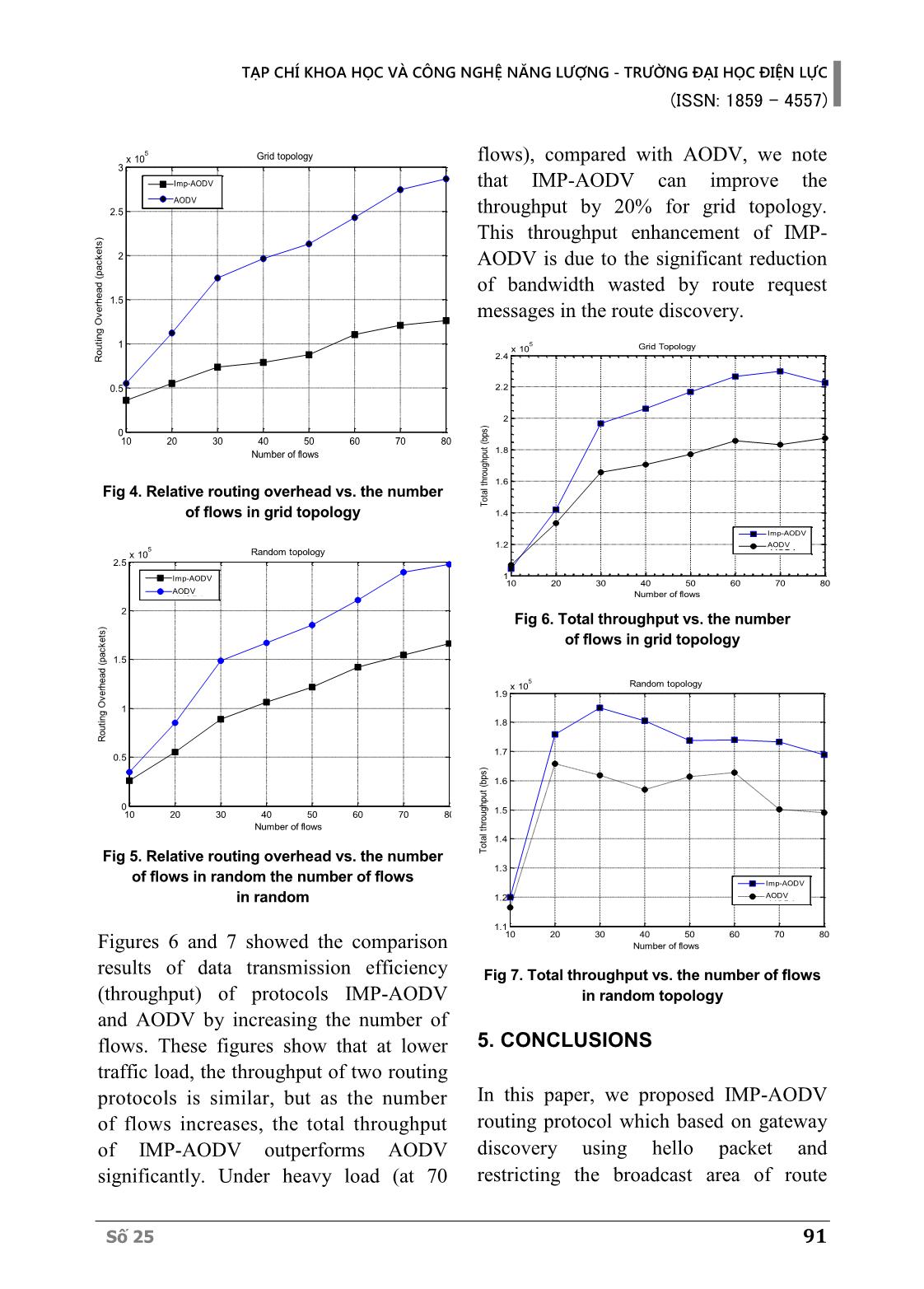
Trang 7
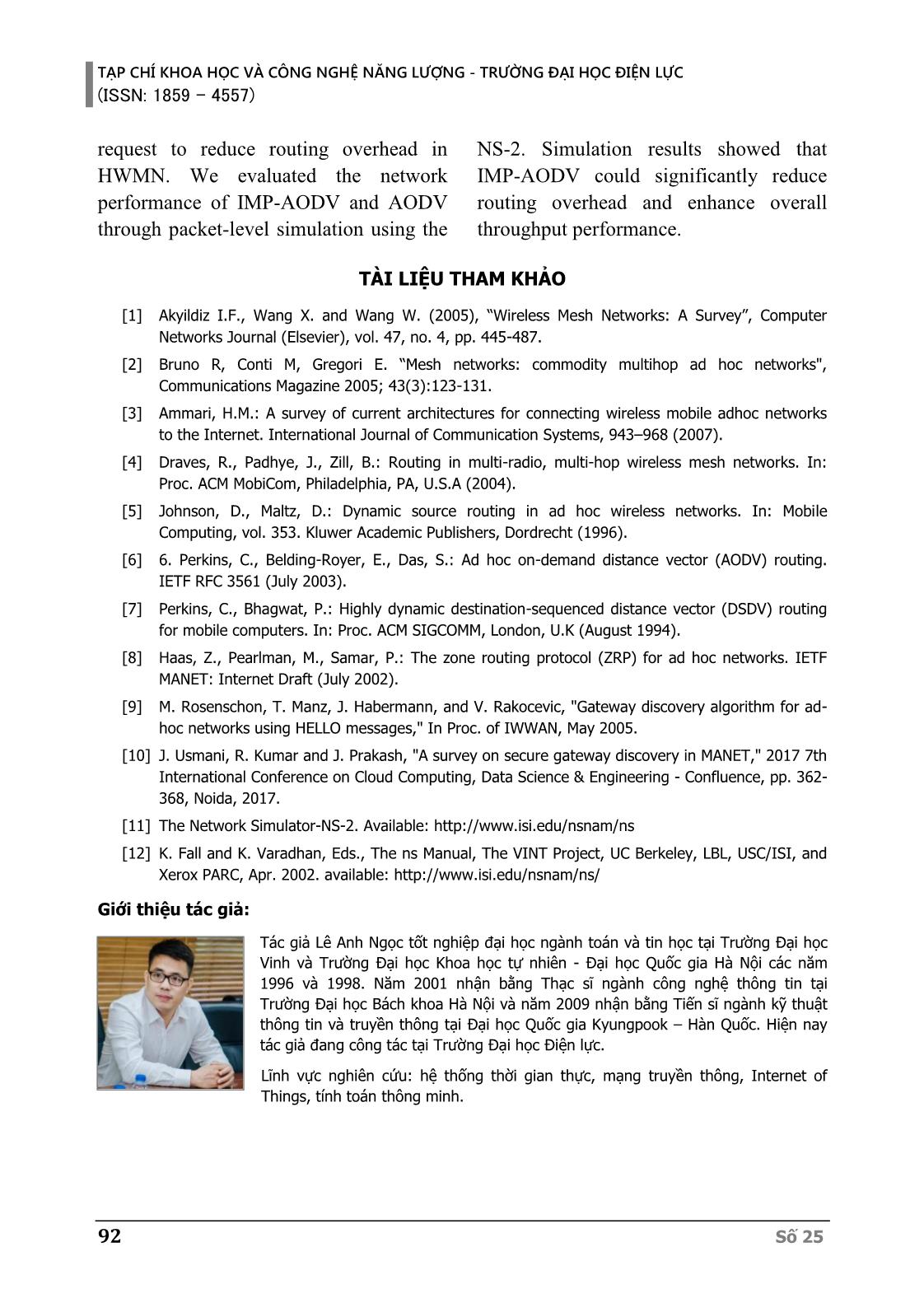
Trang 8

Trang 9
Bạn đang xem tài liệu "Thuật toán định tuyến sử dụng vị trí gateway qua quảng bá gói tin hello trong mạng hình lưới không dây lai", để tải tài liệu gốc về máy hãy click vào nút Download ở trên
Tóm tắt nội dung tài liệu: Thuật toán định tuyến sử dụng vị trí gateway qua quảng bá gói tin hello trong mạng hình lưới không dây lai
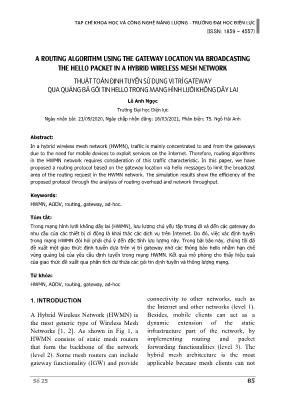
hybrid routing protocol RREQ contains an ID, source address, based on the notion of a zone, where a destination address, sequence number proactive protocol is used among the together with a hop count and control nodes of a particular zone, while a flags. If the RREQ recipients have not reactive protocol is used to reach a node seen the source address and RREQ ID outside that zone. However, this routing pair or do not have a fresher (with a protocol was designed for homogeneous higher sequence number) route to the ad hoc networks, and is unable to destination, they rebroadcast the same differentiate between the different types packet after incrementing the hop-count. of node in hybrid wireless mesh networks. Intermediate nodes also create and preserve a Reverse Route to the source Ad hoc routing protocols are promising node for a certain interval of time. When candidates for hybrid wireless mesh net- the RREQ reaches the destination node or works, due to their capability to deal with any node that has a fresh route to the dynamic environments. However, the destination, a Route Reply (RREP) packet direct application of routing techniques is generated and unicast back to the for ad hoc networks to hybrid wireless source of the RREQ. Each RREP contains mesh networks results in inferior the destination sequence number, source performance, as the characteristics of and destination node addresses, route mesh networks are not utilized. In hybrid lifetime, and hop count and control flags. wireless mesh networks, most of the Each intermediary node that receives the traffic is directed towards a gateway and RREP then increments the hop-count, thus all the source nodes require a route to establishes a Forward Route to the source a gateway node for data delivery beyond of the packet, and transmits the packet via the mesh. Reactive routing protocols [5, the Reverse Route. To preserve the 6] generate multiple requests towards a connectivity information, each node gateway, they increase the traffic and Số 25 87 TẠP CHÍ KHOA HỌC VÀ CÔNG NGHỆ NĂNG LƯỢNG - TRƯỜNG ĐẠI HỌC ĐIỆN LỰC (ISSN: 1859 - 4557) overhead near the gateway. Moreover, in performance. the case of a large network, the time In this section, we introduce IMP-AODV required to acquire a route towards a routing protocol for HWMN, which is an gateway becomes significant, thereby improvement of AODV routing protocol increasing the overall delay. Conversely, in the case of proactive routing protocols based on gateway discovery using hello [7], each node periodically sends updates packet and restricting the broadcast area of its routing table to maintain correct of route requests to reduce routing route information to all destinations, overhead in HWMN. which results in a large overhead. In 3.1. Gateway discovery particular, the high mobility of the mesh clients degrades the performance of The AODV uses periodical HELLO proactive routing, as the routing table messages to indicate the presence of a becomes quickly outdated and requires an mesh node to its neighbors. We utilized it enormous overhead to keep it up to date. for gateway discovery without any In addition, since ad hoc routing protocol overhead. HELLO message is protocols were originally designed for modified with I-flag to indicate that these homogeneous ad hoc networks, consisting packets were originated by a gateway of resource-constrained mobile devices, [9,10]. It also contains the gateway’s their performance is not optimal in hybrid address and the distance value of the wireless mesh networks, as they are broadcasted mesh node. unable to take full advantage of the mesh routers in hybrid wireless mesh networks. Each mesh node maintains a distance value (HC) to indicate the distance 3. PROPOSED ROUTING PROTOCOL (number of hops) to a gateway, which is FOR HYBRID WIRELESS MESH initially set to be infinite. Only a NETWORKS gateway’s HC value is set to 0. Mesh As mentioned in the previous section, the nodes periodically send HELLO message large amount of overhead needed in to update neighbor information, broadcasting RREQ messages is the main meanwhile, gateway node broadcasts drawback of the AODV in high load net- HELLO with gateway information works such as HWMN. The overhead (I-Flag) and distance value (HC+1) (Fig. mostly consists of route request messages. 2a). When mesh nodes within one-hop In the route discovery process, each away from the gateway receive a HELLO intermediate node can broadcast packets message with I-flag and smaller distance to all neighbors whereas most traffic is value (HCHELLO), they update gateway destined from mesh clients to the gateway information and set their HC value with in HWMN. These increase the number of the HC value in the HELLO message. redundant messages transmitted in the Mesh nodes later broadcast their HELLO network and reduce the network message with I-flag and their new HC 88 Số 25 TẠP CHÍ KHOA HỌC VÀ CÔNG NGHỆ NĂNG LƯỢNG - TRƯỜNG ĐẠI HỌC ĐIỆN LỰC (ISSN: 1859 - 4557) value (Fig 2b). Thereafter, the two-hop When mesh node desires a route to a away nodes receive these HELLO gateway for which it does not have a packets, thus they learn that they are two- route, it broadcasts the RREQ with an HC hop away from the gateway. In this set to its HC value as shown in Fig. 3(a). manner, every node discovers the When a mesh node receives a RREQ gateway’s information and learns their message with a smaller distance value distance (HC) to the gateway. Imp-AODV (HC), it discards RREQ message. also used sequence number in HELLO Otherwise, it replaces the HC value on the packet to determine the timeliness of each RREQ with its HC value and then re- packet. broadcasts the RREQ to all neighbors in the same manner in AODV (Fig. 3b). Begin Begin Begin Begin Generate the Node i receives HELLO packet HELLO packet Node i receives Generate RREQ RREQ packet HCRREQ=HCS No No Node i has Packet has Gateway ID Gateway ID Yes No HCRREQ<HCi Yes Yes HC =HC No Broadcast RREQ RREQ i HCHELLO=HCi+1 Discard HC <HC GatewayID =GatewayID HELLO i RREQ packet HELLO i Forward RREQ Yes packet End HCi=HCHELLO Broadcast GatewayIDi=GatewayIDHELLO HELLO packet End Update the neighbor End information (a) Source mesh node; (b) Intermediate mesh nodes End Fig 3. Route Request Forwarding (a) Sending Hello (b) Receiving Hello When a mesh node receives the RREQ, it with I-Flag with I-Flag establishes a reverse route to the RREQ Fig. 2. Gateway discovery algorithm source in its routing table, and it either 3.2. Route discovery replies to the RREQ if it has an entry for the gateway or it forwards the RREQ. The route discovery in IMP-AODV is Finally, the RREQ reaches the gateway fundamentally similar with AODV. It and it unicasts a RREP. The node only improves RREQ forwarding process receiving a RREP sets up a forward route such that reduces the scope of to the gateway and desirable routes can be broadcasting to the gateway. IMP-AODV discovered. protocol adds distance value (HC field) to the Route Request (RREQ) message to Route maintenance is similar to that of the indicate the distance to the gateway. AODV. An existing routing entry may be Số 25 89 TẠP CHÍ KHOA HỌC VÀ CÔNG NGHỆ NĂNG LƯỢNG - TRƯỜNG ĐẠI HỌC ĐIỆN LỰC (ISSN: 1859 - 4557) invalidated if it is not used within a 10, 20, 30, 40, 50, 60, Number of flows specified time interval, or if the next hop 70, 80 node is no longer reachable. In these Traffic type CBR (UDP) cases, an invalidation notice is propagated Packet size 512 bytes Number of mesh to the neighbors that have used this node 99 as the next hop. Each time a route is used nodes Number of to forward a data packet, its route 01 gateways expiration time is updated. When a node Topology Random, Grid detects that a route to a neighbor is no longer valid, it removes the invalid entry 4.2. Simulation results and sends a route error message to the To evaluate the efficiency of the IMP- neighbors that are using the route. Nodes AODV routing protocol, the network that receive error messages will repeat performance parameters used for this process. Finally, the source requests a evaluation including throughput and new route if one is still needed to that relative routing overhead. destination. Throughput: This is defined as the 4. PERFORMANCE EVALUATION amount of data that is transmitted through the network per unit time, (i.e., data bytes 4.1. Simulation parameters delivered to their destinations per second). To evaluate the performance of the Relative routing overhead: The ratio of proposed routing protocol, simulations the number of routing control packets were performed using the NS-2 network over the number of delivered data packet. simulator [11,12]. A hybrid wireless mesh Figures 4 and 5 compared the relative network with 99 mesh nodes and 01 routing overhead between AODV and gateway deployed on an area of 2000m x IMP-AODV protocols for a random and 2000m. We evaluated for 02 topologies: grid topologies. The relative routing grid and random. For the grid topology, overhead between two routing protocols nodes are distributed 200 m apart. For the becomes to be more distinct as the random topology, we generated using number of flows increases from 10 to 80 setdest program in NS2. in HWMN. Under the heavy load, IMP- AODV can significantly reduce the Table 1.Simulation Parameters routing overhead (by about 54% at 80 Routing Protocol AODV vs. IMP-AODV flows in grid topology) for traffic destined Simulation time 250 seconds to the gateway. This improvement is due Simulation Area 2000 × 2000 m2 to the IMP-AODV protocol restricting the Transmission broadcast area of route request to reduce 250 m range routing overhead in HWMN. 90 Số 25 TẠP CHÍ KHOA HỌC VÀ CÔNG NGHỆ NĂNG LƯỢNG - TRƯỜNG ĐẠI HỌC ĐIỆN LỰC (ISSN: 1859 - 4557) 5 x 10 Grid topology flows), compared with AODV, we note 3 ImpD-AODV-AODV that IMP-AODV can improve the AODVAODV 2.5 throughput by 20% for grid topology. This throughput enhancement of IMP- 2 AODV is due to the significant reduction of bandwidth wasted by route request 1.5 messages in the route discovery. 5 1 x 10 Grid Topology 2.4 Routing Overhead (packets) Overhead Routing 0.5 2.2 2 0 10 20 30 40 50 60 70 80 1.8 Number of flows 1.6 Fig 4. Relative routing overhead vs. the number Total throughput (bps) Total throughput of flows in grid topology 1.4 ImpD-AODV-AODV 1.2 AODV 5 AODV x 10 Random topology 2.5 Imp-AODV 1 D-AODV 10 20 30 40 50 60 70 80 AODVAODV Number of flows 2 Fig 6. Total throughput vs. the number of flows in grid topology 1.5 5 x 10 Random topology 1.9 1 1.8 Routing Overhead (packets) Overhead Routing 1.7 0.5 1.6 0 10 20 30 40 50 60 70 80 1.5 Number of flows 1.4 Fig 5. Relative routing overhead vs. the number (bps) Total throughput 1.3 of flows in random the number of flows ImpD-AODV-AODV in random 1.2 AODVAODV 1.1 10 20 30 40 50 60 70 80 Figures 6 and 7 showed the comparison Number of flows results of data transmission efficiency Fig 7. Total throughput vs. the number of flows (throughput) of protocols IMP-AODV in random topology and AODV by increasing the number of flows. These figures show that at lower 5. CONCLUSIONS traffic load, the throughput of two routing protocols is similar, but as the number In this paper, we proposed IMP-AODV of flows increases, the total throughput routing protocol which based on gateway of IMP-AODV outperforms AODV discovery using hello packet and significantly. Under heavy load (at 70 restricting the broadcast area of route Số 25 91 TẠP CHÍ KHOA HỌC VÀ CÔNG NGHỆ NĂNG LƯỢNG - TRƯỜNG ĐẠI HỌC ĐIỆN LỰC (ISSN: 1859 - 4557) request to reduce routing overhead in NS-2. Simulation results showed that HWMN. We evaluated the network IMP-AODV could significantly reduce performance of IMP-AODV and AODV routing overhead and enhance overall through packet-level simulation using the throughput performance. TÀI LIỆU THAM KHẢO [1] Akyildiz I.F., Wang X. and Wang W. (2005), “Wireless Mesh Networks: A Survey”, Computer Networks Journal (Elsevier), vol. 47, no. 4, pp. 445-487. [2] Bruno R, Conti M, Gregori E. “Mesh networks: commodity multihop ad hoc networks", Communications Magazine 2005; 43(3):123-131. [3] Ammari, H.M.: A survey of current architectures for connecting wireless mobile adhoc networks to the Internet. International Journal of Communication Systems, 943–968 (2007). [4] Draves, R., Padhye, J., Zill, B.: Routing in multi-radio, multi-hop wireless mesh networks. In: Proc. ACM MobiCom, Philadelphia, PA, U.S.A (2004). [5] Johnson, D., Maltz, D.: Dynamic source routing in ad hoc wireless networks. In: Mobile Computing, vol. 353. Kluwer Academic Publishers, Dordrecht (1996). [6] 6. Perkins, C., Belding-Royer, E., Das, S.: Ad hoc on-demand distance vector (AODV) routing. IETF RFC 3561 (July 2003). [7] Perkins, C., Bhagwat, P.: Highly dynamic destination-sequenced distance vector (DSDV) routing for mobile computers. In: Proc. ACM SIGCOMM, London, U.K (August 1994). [8] Haas, Z., Pearlman, M., Samar, P.: The zone routing protocol (ZRP) for ad hoc networks. IETF MANET: Internet Draft (July 2002). [9] M. Rosenschon, T. Manz, J. Habermann, and V. Rakocevic, "Gateway discovery algorithm for ad- hoc networks using HELLO messages," In Proc. of IWWAN, May 2005. [10] J. Usmani, R. Kumar and J. Prakash, "A survey on secure gateway discovery in MANET," 2017 7th International Conference on Cloud Computing, Data Science & Engineering - Confluence, pp. 362- 368, Noida, 2017. [11] The Network Simulator-NS-2. Available: [12] K. Fall and K. Varadhan, Eds., The ns Manual, The VINT Project, UC Berkeley, LBL, USC/ISI, and Xerox PARC, Apr. 2002. available: Giới thiệu tác giả: Tác giả Lê Anh Ngọc tốt nghiệp đại học ngành toán và tin học tại Trường Đại học Vinh và Trường Đại học Khoa học tự nhiên - Đại học Quốc gia Hà Nội các năm 1996 và 1998. Năm 2001 nhận bằng Thạc sĩ ngành công nghệ thông tin tại Trường Đại học Bách khoa Hà Nội và năm 2009 nhận bằng Tiến sĩ ngành kỹ thuật thông tin và truyền thông tại Đại học Quốc gia Kyungpook – Hàn Quốc. Hiện nay tác giả đang công tác tại Trường Đại học Điện lực. Lĩnh vực nghiên cứu: hệ thống thời gian thực, mạng truyền thông, Internet of Things, tính toán thông minh. 92 Số 25 TẠP CHÍ KHOA HỌC VÀ CÔNG NGHỆ NĂNG LƯỢNG - TRƯỜNG ĐẠI HỌC ĐIỆN LỰC (ISSN: 1859 - 4557) Số 25 93
File đính kèm:
 thuat_toan_dinh_tuyen_su_dung_vi_tri_gateway_qua_quang_ba_go.pdf
thuat_toan_dinh_tuyen_su_dung_vi_tri_gateway_qua_quang_ba_go.pdf

